CHOP AND LIFT: WHAT, WHY, WHEN AND HOW.
Introduction:
The Chop and Lift is a great exercise to help correct movement patterns, increase whole body integration and eliminate compensation patterns as well as provide an effective training stimulus to develop power, strength, stamina and stability (control).
There are many, many different ways to perform the Chop and Lift. Each variation of the Chop and Lift offers a different kind of benefit to it, all of which will be discussed in the following sections.
ARTICLE ROADMAP:
This article will go into depth in many aspects of the Chop and Lift. Therefore, here is a brief roadmap to guide you to the sections of the article that are most important to you:
• WHAT – PNF Patterned and Tri-planar or Multi-planar Movements
• WHY – Improving Movement Quality
Increases Stability and Integration
• WHEN – Chops and Lifts can be used:
Corrective Strategies
Movement Prep
Train a Fitness Component, including power, strength and endurance.
• HOW – Progress/Regress the Chop and Lift for Stability and Integration
Five Variables Defined and Illustrated:
Type: Rotational or Stability
Vector: Chop, Lift and Horizontal Chop
Action: Hinge Chop, Swing Chop and Chop-to-Press
Grip: Narrow, Wide and Split Arms
Stance: Seated, Half Kneeling, Tall Kneeling, Standing, Split Stance, Lunge and Single Leg.
Exercise Prescription – Assigning the appropriate Sets and Reps for the Chop and Lift.
Conclusion
WHAT IS THE CHOP AND LIFT
The Chop and Lift are a couple of simple exercises that can be modified and changed a hundred times over and used for numerous purposes, from correcting an individual’s movement patterns to increasing an individual’s total power output in a punch, swing or stride.
This article will focus on the progression of Chop and Lift exercise variations as it pertains to Movement Quality, Stability and Integration.
PNF Movement Patterns
The Chop and Lift, named for its resemblance to the diagonal downward swing of an axe and its opposing upward lifting movement, are categorized as Proprioceptive Neuromuscular Facilitation (PNF) patterns given that it follows a diagonal arc of motion relative to the midline of the body.
PNF movement patterns are fundamental to human movement and are characterized by diagonal and/or spiral vectors, or line of actions, and involve the simultaneous coordination of several joints. Training this type of movement is integral to optimal performance because it results in forces being exerted on the body that lie outside of more traditional, more square movement patterns. Rather than adapting to move solely forward/backward, left/right, or up/down, PNF patterns require stabilization and movement across all planes of motion and require the body to integrate and coordinate movement across multiple joints.
PNF Movement Patterns are diagonal and/or spiral line of actions (vectors) that transmit kinetic energy through the body.
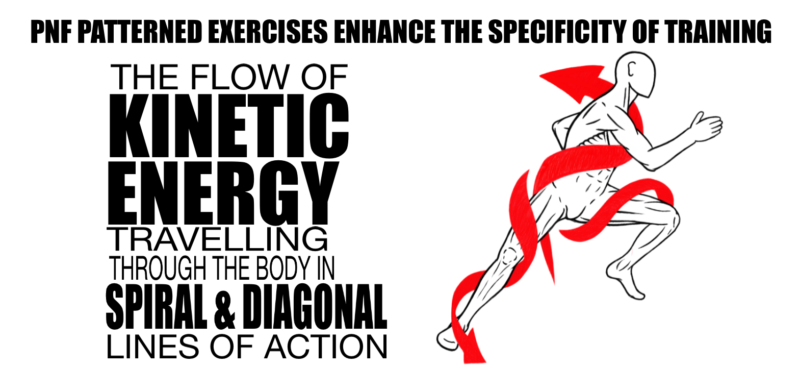
Tri-planar (Multi-planar) Movement
Additionally, the Chop and Lift is an example of an exercise that creates a tri-planar training environment in that it operates through all three planes of motion; Sagittal, Transverse and Frontal. Tri-planar or multi-planar movements are very beneficial in a training program because they can systematically counter balance the repetitive nature of an individual’s sport or lifestyle behaviors that may only occur in one or two of these planes.
Tri-planar/Multi-planar Exercises help further develop stability and integration across multiple joints and contribute to an increase in speed, power and strength.

WHY USE THE CHOP AND LIFT
The Chop and Lift can be found in many different strength and conditioning programs because it’s ability to create power, speed and strength. These training programs may incorporate a host of ballistic exercises where individuals toss, catch and swing medicine balls in a Chop, Lift or Horizontal Chop exercises.
Ballistic Chop and Lift exercises can help an individual apply more gross power, strength and even endurance in virtually every type of movement.
Main Focus: Improving Movement Quality
Even though the Chop and Lift is used many times over to help cultivate more power and strength for specific movements, such as throwing, jumping or sprinting, this article will focus on how the Chop and Lift help increase stability and integration through the body, which will help to improve an individual’s overall Movement Quality.
Training program that honor longevity in a particular activity and injury prevention will seek to improve Movement Quality as well as strength, power, speed and endurance.
In his seminar, FMS Corrective Exercise Strategies, Matt Berenc, the Director of Equinox Fitness Training Institute, states that “prioritizing and training to optimize Movement Quality will lead to improvements in performance and increases in longevity as well as reduce the risk of injury, make the body more adaptable and resilient to stressors, maximize results in training and effectively help a coach or trainer know where to start the training progression for his/her client or athletes.” (Berenc 2017)
The Chop and Lift has been shown to improve the overall quality of movement in individuals, which is another way of stating that an individual’s movement has become more biomechanically efficient and sound in nature.
STABILITY AND INTEGRATION
When looking to improve Movement Quality, an effective training program must eventually focus on the level of Integration and Stability in the individual’s movement.
As Nick Winkleman, famous for his work with EXOS Training Systems, often echoes, “you can’t shoot a cannon from a canoe.” This simplistic analogy illustrates the importance of ‘stability’ within the realm of human movement and performance. If a cannon is shot from a canoe, the likelihood of the projectile (cannon ball) hitting the target is very low because the canoe provides a horrible base of support for the cannon, whose forceful kickback from shooting the cannon ball would ultimately be too high a magnitude for the buoyancy of the canoe. The end result is likely that the cannonball will miss the target and/or capsize the canoe.
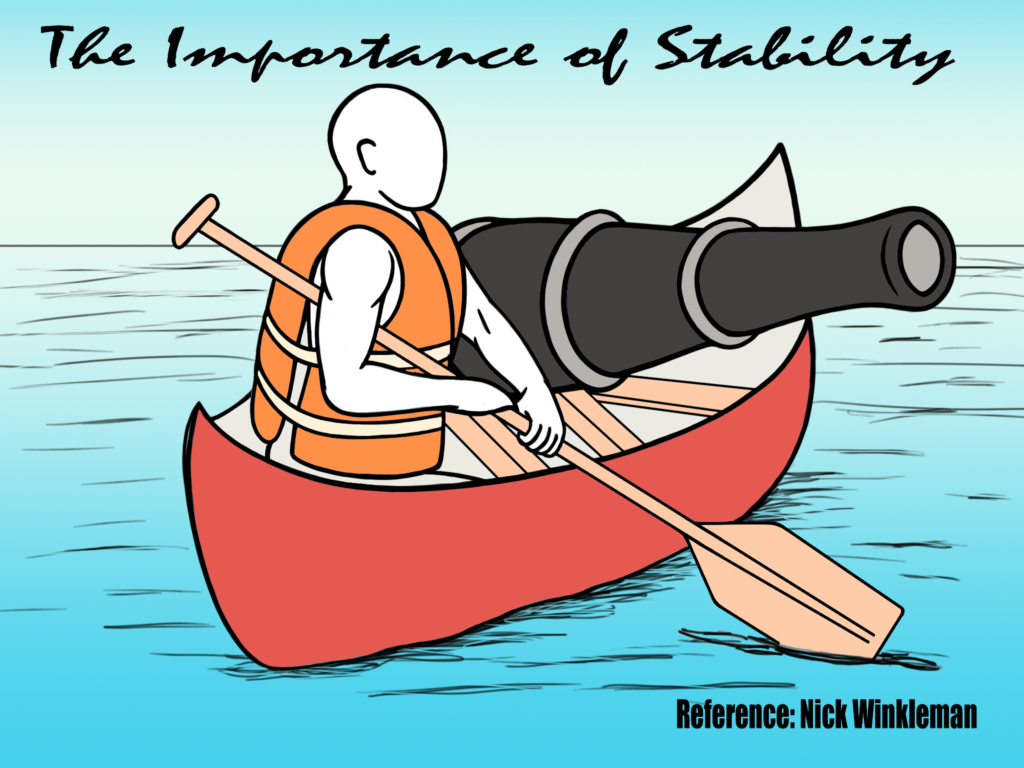
The human body is ultimately an interdependent fleet of 168 canoes, albeit each ‘canoe’ is a joint. Each joint is faced with the same question: does it have a strong enough base of support to control the forces that transitions through it? In order to achieve optimal movement quality and integration each joint in the human body needs to have the necessary pattern of Motor Control (neuromuscular coordination) and requisite level of physiological conditioning (strength and stamina) to be stable enough to handle these forces..
Multi-stability System
Stability exercises are intentionally designed to help an individual develop the proper neuromuscular coordination and conditioning necessary to effectively and efficiently move force through the joints and direct the flow of kinetic energy throughout the body.
There are hundreds of exercises to improve stability, however many of these focus on a single joint segment or region. Human Movement, as well as Human Performance, operates within a ‘multi-stability’ system, meaning that there are several agents that simultaneously affect stability overall (Kelso 2012). Therefore, training with Integration Exercises will help develop individuals’ stability which in turn leads to improvements in Movement Quality as well as performance and longevity.
Chop and Lift can stimultaneously improve Motor Control (Stability) at the Foot, Ankle, Hip, Core (Spine) and Shoulders as well as enhance the individual’s Global Motor Programing.
Integration Exercises
What exactly are ‘integration exercises’? And why are they important to Movement Quality, performance, and longevity? Integration Exercises require multiple joint segments or regions, i.e. Shoulders, Spine, Hips, Foot /Ankle, to simultaneously coordinate and execute Movement Patterns.
The improvement in movement quality mediated by the Chop and Lift exercise progression can be partially explained by changes in stability and integration. Stability is defined as the ability of the body to maintain an intended movement or position in spite of external forces; while integration is one’s ability to effectively transfer kinetic energy from one part of the body to another. A well-integrated movement flows smoothly between contributing joints and muscles, whereas a poorly-integrated movement appears segmented and loses power and stability at weak links as it is executed.
Integration Exercises create a unique training environment, forcing the body to move as one unit. The human body is an interdependent system of levers and pulleys, meaning the action at any one joint will have a consequential effect on the rest of the body as a whole (Frank 2013). In other words, when the elbow flexes to curl a dumbbell, there is an effect throughout the rest of the body. Integration Exercises provide a stimulus that intentionally directs these many levers and pulleys to operate as one unit as opposed to individual joint segments.
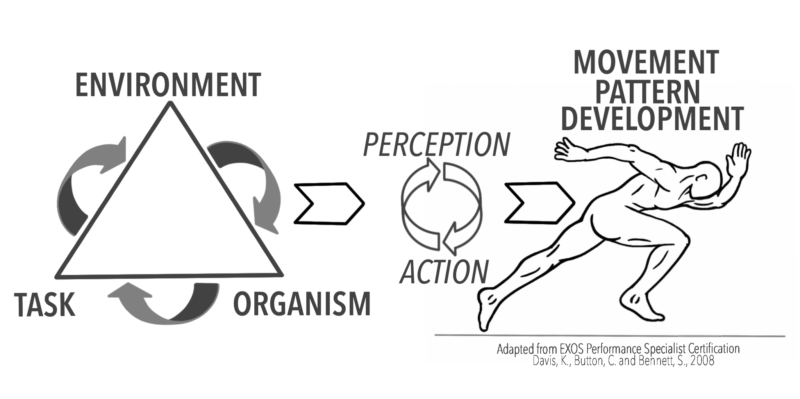
Motor Learning Cycle
When attempting to improve an individual’s Movement Quality, an understanding of the Motor Learning Cycle will help a coach/trainer assign and progress exercises through numerous variations.
Motor Learning refers to the body’s process of learning to coordinate a desired movement. It is a continual cycle of an individual (organism) executing a movement (task) within a specific context (environment) and receiving information (feedback) to process the Motor Control strategy (evaluate), from which adjustments can be made (Kelso 2012).
Integration Exercises, such as the Chop and Lift, provide a training environment for an individual to enhance their Motor Control and thus improve their Movement Quality.
When a synergist or stabilizer is underactive or weak, the end result is a pattern of compensation and or muscle imbalance, which create fixed (subconscious) suboptimal motor programs within the Central Nervous System (CNS) that lead to either chronic pain or poor performance (Frank 2014).
The Chop and Lift Progression can effectively eliminate Suboptimal Motor Control by providing a training environment that relies on the use of synergist muscles and stabilizers.
WHEN TO USE CHOPS AND LIFTS:
According to Berenc there are 3 Main Training Objectives for any exercise:
● Corrective Exercise Strategy – attempting to eliminate a strength or muscular imbalance, or retraining fundamental movement patterns and reducing patterns of compensation.
● Movement Prep – preparing the body to adequately handle a specific mode of stress – typically the main objective of a training session.
● Training a Fitness Component – exposing the body to specific stresses in order to foster an physiological and neuromuscular adaption of either strength, power or endurance.
Understanding the objective of the exercise is critical in determining when and how to perform any given exercise. In regards to Movement Quality, the Chop and Lift can be an effective exercise selection for use in a Corrective Strategy, a Movement Prep routine or even to help further develop strength, endurance or skill in a Movement Pattern that can positively translate over into a specific skill used in performance, such as throwing, swinging or cutting.
The Chop and Lift can be used to serve any one of the three training objectives: Corrective, Prep or Stress (Training a Fitness Component).
IMPLEMENTING CHOPS AND LIFTS WITH A.M.A.S.S.
Since there are numerous ways that the Chop and Lift can be implemented into a training program, the A.M.A.S.S. Method, which created by Michael Rosengart, CPT, CES, CSCS, can offer a simplified framework for when to use a Chop or Lift in a training program.
The A.M.A.S.S. Method is a systems approach to PreHab and Training Programs that serves as a workflow guide to tailor programs to individual needs and abilities.
The acronym represent the five system stages of training:
Assess
Mobilize (Increase Range of Motion)
Activate (Increase Neuromuscular Tension)
Stabilize (Improve Neuromuscular Motor Control)
Stress (Increase Strength, Power, Endurance or Skill)
Note: ‘Stress’ had been termed Strength in other articles and books, but refers the same objective of increasing Strength, Power, Endurance and Skill.
Step One – Assess
Once training goals are defined the next step is to assess individual needs in regards to movement, fitness and health. Evaluation tools or screenings such as the Functional Movement Screen (FMS), or those championed by the Postural Restoration Institute (PRI), or National Academy of Sports Medicine (NASM) can be used to assess individuals, uncover muscular imbalances, patterns of compensation, and inefficient movement patterns, then suggest corrective exercise strategies to optimize movement.
The Chop and Lift can be used to help correct or eliminate several different Compensation Patterns and Movement Dysfunctions.
To learn more about Compensation Patterns and Movement Dysfunctions, visit the corresponding article at www.prehabexercises.com/compensation-patterns
Step Two – Mobilize
Just as there are several ways to assess an individual’s movement, here are numerous techniques to improve an individual’s level of mobility. According to the A.M.A.S.S. Method, it is essential to address and effectively improve an individual’s Range of Motion and overall level of Mobility before practicing the Chop and Chop within a training session.
In his EFTI workshop for ‘FMS Corrective Strategies’, Berenc echoes a sentiment that many others believe in: Mobility training must proceed Stability training because there needs to be the freedom to move before control (Motor Control) can be developed. Mobility first. Stability second. (Berenc 2017)
Soft Tissue Therapy techniques, including Foam Rolling, and Active Mobility Drills, such as CARs, PNF Stretching and more, can be used to improve an individual’s Range of Motion throughout the Shoulders, Thoracic Spine and Hips, all of which will have an impact on how an individual performs the Chop and Lift.
For an illustrated guide to Foam Rolling, CLICK HERE.
Additionally, the use of the Chop and Lift over time can strengthen several different muscle groups, particularly in a rotational movement pattern, that can help improve an individual’s Active Range of Motion and overall Mobility.
Step Three – Activate
Many individuals only experience a handful of bodily positions each day due to the limited demands of modern lifestyles. The S.A.I.D. principle (Specific Adaptions to Imposed Demands) dictates that the body will adapt only to the positions and movement (demands) that it experiences. The result for many is limited activation of muscle fibers in the body due to the prominence of low-demand tasks that occur in stable and restricted ranges of motion throughout modern life.
For example, a person who regularly hikes along steep and uneven paths experiences greater neuromuscular activity than a peer who walks the same distance along a flat concrete sidewalk due to the demands of these different kinds of walking surfaces.
The limited variety of physical activity in a modern lifestyle will lessen the diversity and amount of neuromuscular activity an individual experiences on a daily basis and negatively affect an individual’s level of Mobility and Stability.
Unfortunately for most, there is great need to incorporate Integration Exercises into training programs due to the fact that modern lifestyles of many in developed nations includes a great deal of inactivity as the combined advances in technology, automation and manufacturing has made movement unnecessary for survival (Bowman 2016 and NASM 2013).
In other words, many people do not need to move in order to survive in today’s world. The consequences of inactivity are apparent as people’s bodies are literally deforming due to the repetitive nature of some lifestyle factors. For example, a study proved that the Achilles Tendon and Gastrocnemius (Calf) muscle in women that habitually wear high heels can shorten and lose sarcomeres, the basic contractile unit of striated muscle fibers. Consequentially, the way that people move is also changing due to today’s modern lifestyle (Bowman 2014).
More than ever before the most common and least taxing activity of modern living is sitting. Spending long periods of time in a seated position does little to activate the musculature of the shoulder, core, hips, knees, feet, or ankles, and has been established as an independent risk factor for early mortality. (Katzmarzyk et al, 2009).
The Chop and Lift can be an effective exercise to counteract the muscular detraining from this type of lifestyle as it utilizes many of the muscles that are under-activated by tasks of modern living, particularly those in the shoulders, core and hips, i.e. The Pillar.
Screen with Soft Rolling
Many people may lack the Motor Control that helps the hips, spine and shoulders, also known as the Pillar, to move in an integrated manner. ‘Soft Rolling’ exercises are an effective way to screen the level of integrated Motor Control through the Pillar, and is detailed below.
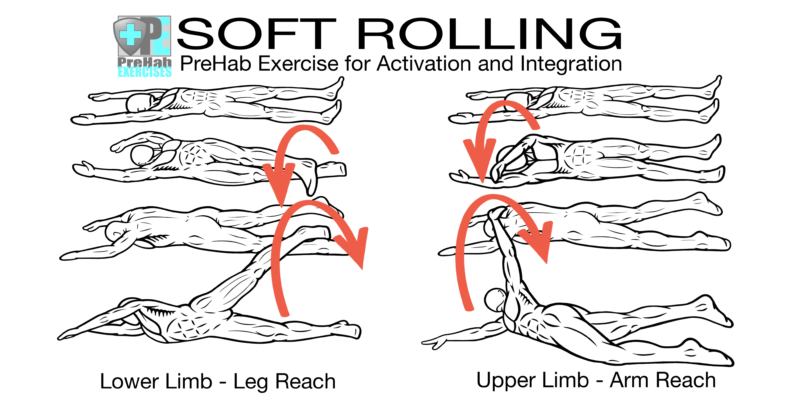
To perform Soft Rolling: While lying on the stomach or back with arms reaching over the head, reach across the body with one limb while relaxing the rest of the body. The limb reach should have enough Active Range of Motion to create enough leverage that will roll the body completely over without any help from the other three limbs.
The use of the Chop and Lift in a training program will increase and diversify the amount of neuromuscular activity in the body and lead to improvements in an individual’s level of Mobility and Stability.
Step Four – Stabilize
Stability, as it pertains to human movement, can be characterized as a combination of motor control and neuromuscular integration. The Chop and Lift requires coordinated movement, and resistance to movement, across multiple extremities and muscle groups the effect of which is a training stimulus for both motor control and integration.
Stability in human movement can be defined as the ability to resist change and control the path of body segments in space, which requires integrated Neuromuscular Coordination and adequate Motor Control.
The Chop and Lift, with all of its variables, offers a continual progression of exercise stimulus and movement demand that can help an individual improve Neuromuscular Coordination (Integration) and effective develop Motor Control (Stability).
Once individuals have become accustomed to a particular variation of the exercise motor control and integration can be further challenged by pursuing a more challenging or less familiar variation.
Small changes in an exercise like the Chop and Lift can lead to significant differences in the body’s ability to integrate movement, thus allowing for a new training stimulus.
Step Five – Stress (Strength, Power, Endurance and Skill)
Strength is applied in this context as an umbrella term for a variety of fitness components including power, maximal strength, functional strength, local muscular endurance, skill development, speed and more.
The Chop and Lift can be manipulated to create an ideal stimulus that will force specific adaptations in regards to specific fitness components. For example, exercises such as the Med Ball Throw, or Tire Chops can be used to improve muscular power while producing the PNF movement pattern we seek to train with the Chop and Lift. Alternatively higher repetitions of a similar movement may be more fitting for an endurance athlete seeking to train for the demands of their sport.
HOW – SETTING UP FOR CHOPS AND LIFTS
The Chop and Lift can be progressed through five different variables, from which hundreds of specific exercises can be created. As mentioned before, ‘form is function,’ especially as it pertains to exercise and training programs, which is why it is important to understand each of the variables and how they can impact the training effect of the Chop and Lift.
Chop and Lift Variables
In order to determine the most effective application of the Chop and Lift one must consider the training needs of the individual and then set the following variables in the movement:
Exercise Type:
Rotational
Stability
Movement Pattern – Vector:
Chop
Lift
Horizontal Chop
Movement Pattern – Action:
Elbow Hinge (Hinge)
Straight Arm (Swing)
Hinge to Press (Chop-to-Press)
Position – Grip:
Wide Grip
Narrow Grip
Split Arms
Position – Stance:
Seated – Stable (Box) and Unstable (Physio Ball)
Half Kneeling (Contralateral & Ipsilateral)
Tall Kneeling
Wide Stance (Standing)
Athletic Stance (Standing)
Narrow Stance (Standing)
Stagger Stance (Contralateral & Ipsilateral)
Short-Foot Stagger Stance (Contralateral &I psilateral)
Lunge Stance (Contralateral & Ipsilateral)
Single-Leg (Contralateral & Ipsilateral)
VARIABLES DEFINED:
Here are some brief descriptions of each variable of the Chop and Lift.
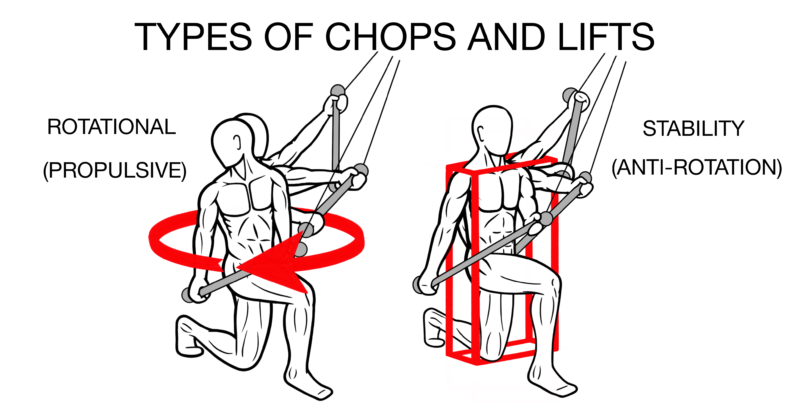
EXERCISE TYPE: ROTATIONAL AND STABILITY
Stability is the ability to maintain position and control of movement despite external forces. Rotation is the ability to effectively create, maintain and absorb torque, rotational movement around an axis. A simpler way to explain the difference is that Stability exercises resist rotation and Rotation exercises create a rotation through the Core or Pillar (Shoulders to Hips).
ROTATIONAL CHOP/LIFT
A Rotational Chop or Lift requires the torso to rotate with the action of the arms in order to coordinate and develop power/strength in a rotational pattern, which is integral in many movement patterns.
STABILITY CHOP/LIFT
A Stability Chop or Lift requires the arms to move around a stable or ‘still’ torso in order to help the individual develop the ability to withstand the rotational forces that will affect the body.
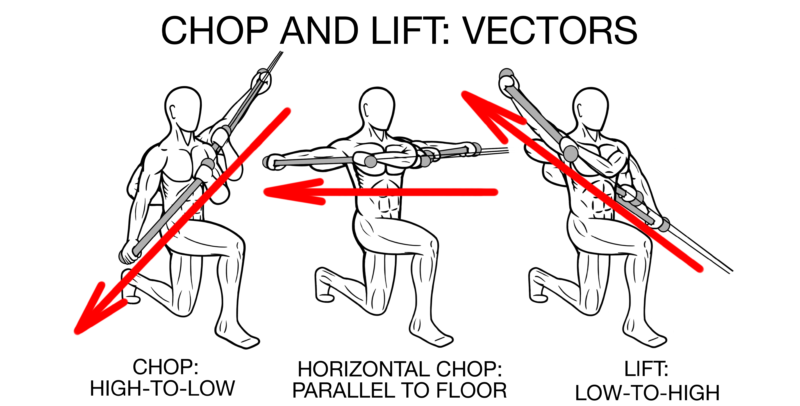
MOVEMENT PATTERN: VECTOR
The exercises in the Chop and Lift Progression are defined by their Movement Pattern, or more specifically, by the vector or direction in which the resistance force is moved throughout the exercise. The Chop and Lift variations occur in one of three vectors.
Chop: Diagonal Movement Pattern across the midline of the body where the resistance force is moved in a High to Low Direction.
Lift: Diagonal Movement Pattern across the midline of the body where the resistance force is moved in a Low to High Direction.
Horizontal Chop: Horizontal Movement Pattern that is perpendicular to the Spine and the resistance force is moved in a Lateral Direction.
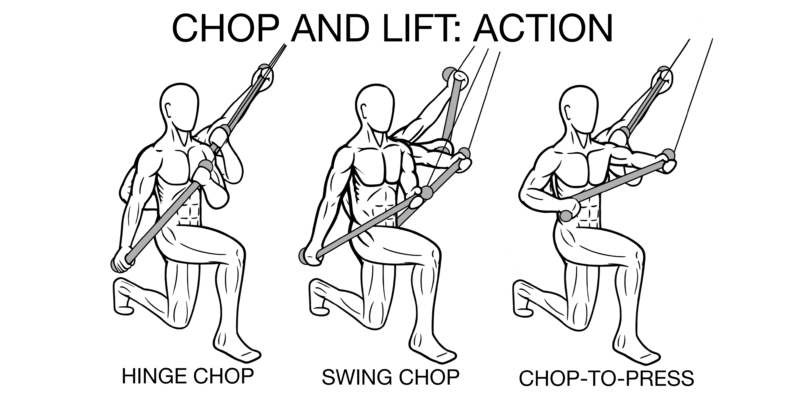
MOVEMENT PATTERN: ACTION
The Chop and Lift have three different patterns through which the action of the exercise is executed: Hinge Chop, Swing Chop and Chop Press.
Hinge Chop: Each arm starts the movement of the exercise with a ‘pull’ by pulling the resistance towards the midline of the body and then transitions into a ‘push’ by pushing the resistance away from the midline. The elbows will hinge (flex and extend) in this pattern.
Swing Chop: The arms will swing or move the resistance handles around the body in an arc while the elbows will remain fully extended throughout the entire movement. This swing or arc pattern will place a high neuromuscular demand on the shoulders and core to move the resistance handles and stable the body in space due to the elongated lever arms made by keeping the resistance at a maximal distance from the body.
Chop-to-Press: The arms will initiate this pattern by pulling the resistance handles towards the midline of the body while flexing the elbows before transitioning into a ‘pressing’ pattern, which involve the arm that is closest to the resistance to push out into full extension as the outside hand holds still and creates and anchor for the resistance handles.
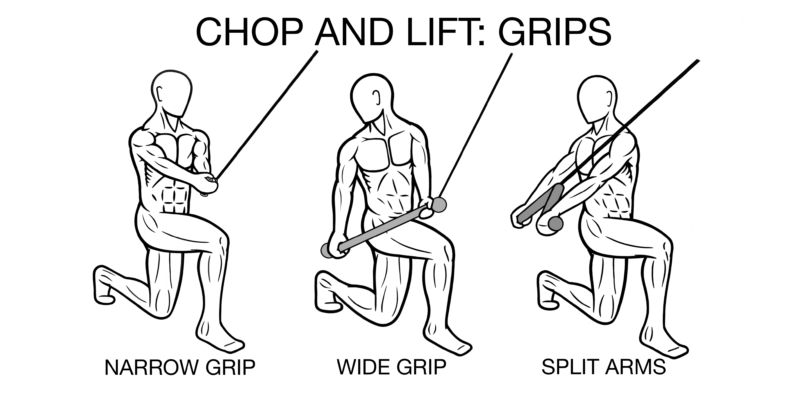
POSITION: GRIP
The Chop and Lift can utilize three different Grips: Bilateral Narrow Grip, Bilateral Wide Grip and Split Arms
Wide Grip (WG): a bilateral grip where the individual’s two hands spread apart upon a cable bar or rope and positioned equidistance (the same distance) from the center of the cable bar or rope. The bilateral WG is the recommended grip used for the Chop-to-Press Action.
Narrow Grip (NG): a bilateral grip where the individual’s two hands cupped over one another on the same small handle for the cable machine or resistance tube/band.
Split Arms: is a bilateral grip where the individual’s two hands on same surface with resistance (cable or resistance tube attachment) in the middle.
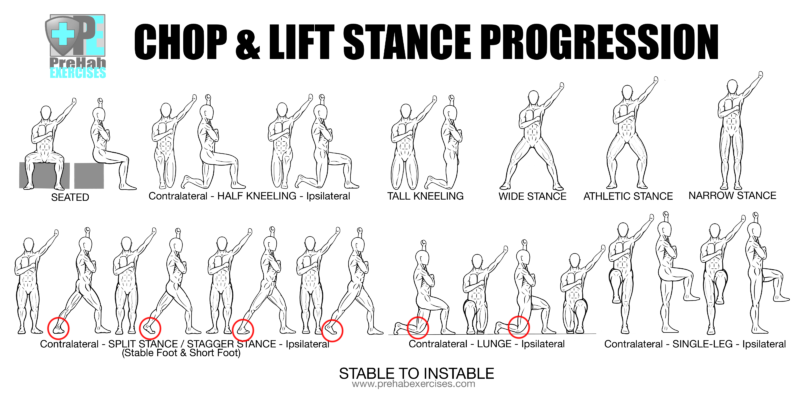
POSITION: STANCE
The Chop and Lift can be progressed through a series of stances or positions to offer increased complexity and decreased stability that will allow individuals to improve movement quality.
Contralateral and Ipsilateral Stances
Any split legged or single-leg stance can be constructed in two different ways: Contralateral and Ipsilateral.
CONTRALATERAL: the individual will rotate/press the opposite arm towards opposite leg.
IPSILATERAL: the individual will rotate/press same-side arm towards same-side leg.
When utilizing both legs the Contralateral Stance is the fundamental pattern of the natural Gait Cycle (walking and running) and is a regressed (less complex) and more stable stance in comparison to an Ipsilateral Stance. When using a single leg stance Ipsilateral Chops and Lifts are more stable than Contralateral Chops and Lifts. Yet, all other stances for Chop and Lifts are regressed in Contralateral and advanced in Ipsilateral.
The following stance progressions are demonstrated and described below and have been arranged from most to least stable:
– Half Kneeling (Contralateral)
– Half Kneeling (Ipsilateral)
– Tall Kneeling
– Seated (Stability/Physio Ball)
– Wide Stance (Standing)
– Athletic Stance (Standing)
– Narrow Stance (Standing)
– Stagger Stance (Contralateral)
– Stagger Stance (Ipsilateral)
– Short-Foot Stagger Stance (Contralateral)
– Short-Foot Stagger Stance (Ipsilateral)
– Lunge Stance (Contralateral)
– Lunge Stance (Ipsilateral)
– Single-Leg (Ipsilateral)
– Single-Leg (Contralateral)
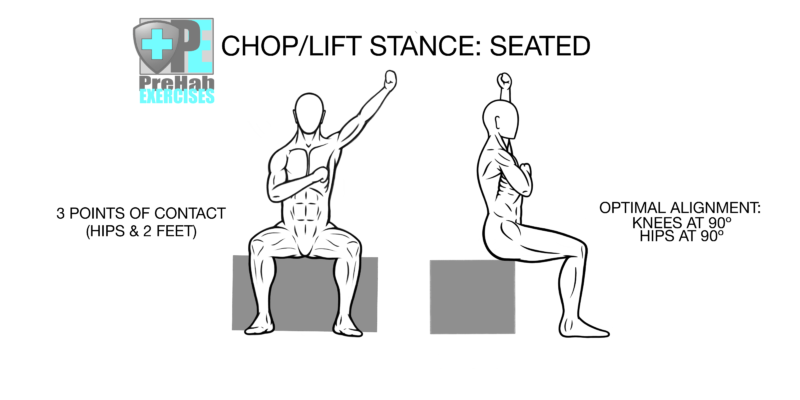
Seated – Both knees at 90 degrees with Feet flat on the floor, positioned at Shoulder width or wider apart.
This stance can be performed on a box/bench or a Stability Ball/Physio Ball, of which the latter will offer a higher level of instability.
Foot Position: A wider foot position offers a higher level of stability and can direct a higher level of force to be concentrated on the Pillar.
Benefits: The Seated Chop and Lift is an adequate way to target the Shoulder, Core to Hip, without too much demand from the Glutes, Ankle and Foot.
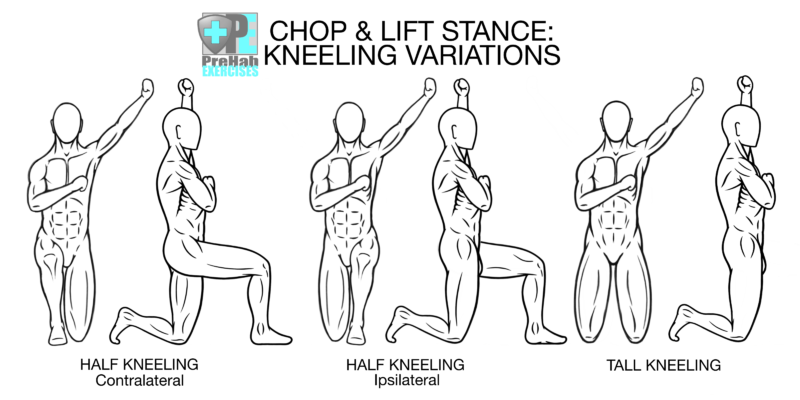
Half Kneeling Contralateral – Inside Knee down, knees at 90 degrees, vertical spine.
Width of the stance, i.e. the width of the knees, will determine the level of instability. The closer the knees are to being on the same Sagittal (front to back) line, the less stable the stance will become.
Toes: Tucking the back toes under will provide more stability to the stance as the Foot and Ankle will contribute to organizing and maintaining the position.
Benefits: Half Kneeling can keep the Pelvis from shifting into an Anterior or Posterior Tilt. Additionally, Half Kneeling is a stance that requires the down leg’s Hip to become more active and contribute to the body’s overall level of Stability.
Half Kneeling Ipsilateral – Outside Knee down, knees at 90 degrees, vertical spine.
Width of the stance, i.e. the width of the knees, will determine the level of instability. The closer the knees are to being on the same Sagittal (front to back) line, the less stable the stance will become.
Toes: Tucking the back toes under will provide more stability to the stance as the Foot and Ankle will contribute to organizing and maintaining the position.
Benefits: Half Kneeling can keep the Pelvis from shifting into an Anterior or Posterior Tilt. Additionally, Half Kneeling is a stance that requires the down leg’s Hip to become more active and contribute to the body’s overall level of Stability.
Tall Kneeling – Both Knees down, pelvis level with the floor, i.e. no anterior or posterior tilt of the pelvis.
Toes: Tucking the back toes under will provide more stability to the stance as the Foot and Ankle will contribute to organizing and maintaining the position.
Benefits: Tall Kneeling forces the Pillar, Hips, Core and Shoulders, to work in an integrated manner in order to maintain stability in the movement.
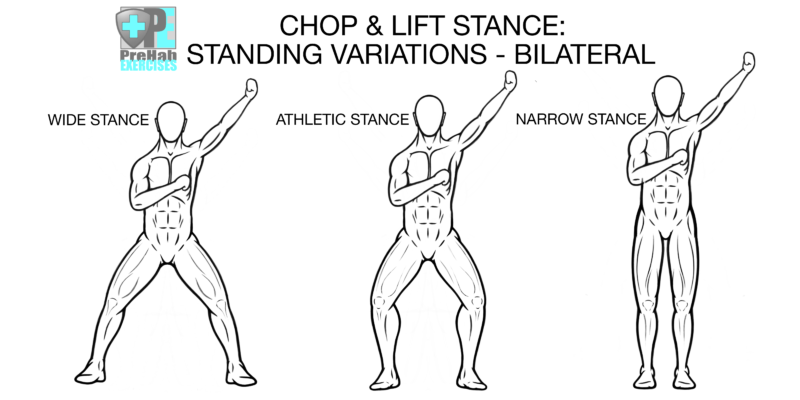
Standing – Wide Stance– Individual stands in a wide stance wherein the legs are positioned at approximately 45 degree angles to maximize the Base of Support and direct more kinetic force through the Pillar while still incorporating the Foot and Ankle for marginal support.
Benefits: This Wide Stance allows an individual to integrate the Foot and Ankle into the overall Motor Control of the movement.
Standing – Athletic Stance – The individual stands with feet positioned shoulder width apart (Glenohumeral Joint vertically aligned with the In-Step). Hips, Knees and Ankles are all slightly flexed while the Spine remains neutral. The heart and shoulder vertically align over the arch of the foot when looking from the side.
Benefits: The individual has the opportunity to train in a position commonly found in sports and life and expose the body to the PNF vector and spiral forces of the Chops and Lifts.
Standing – Narrow Stance – The individual stands with feet positioned inside of shoulder width to introduce a higher level of instability.
Benefits: The small Base of Support increases the level of complexity and instability, which introduces another variation and provides additional afferent signaling to the Central Nervous System that can enhance overall Motor Programing.
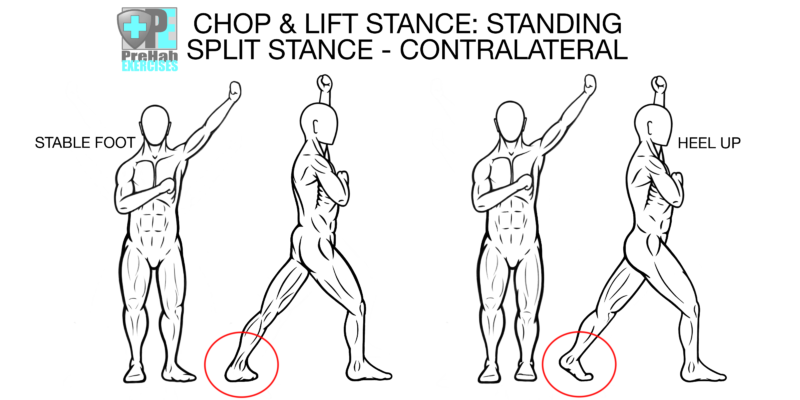
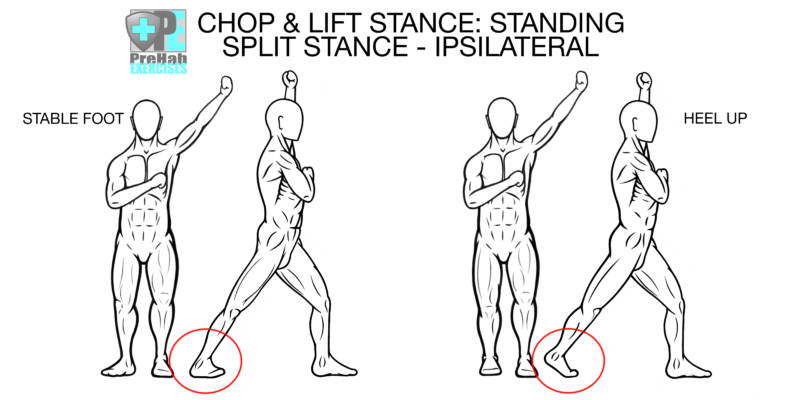
Stagger Stance or Split Stance – The stagger stance is a split legged stance wherein one foot is in front of the hips and the other foot is behind the hips. This stance can be manipulated by Leg Positioning, Foot Position, and Stance Orientation.
Stance Orientation – the stagger stance can be arranged in a Contralateral or Ipsilateral orientation. Just as in Half Kneeling, Contralateral and Ipsilateral positions require different strategies in Motor Control and offer an increased amount of afferent signaling to the Central Nervous System, which will enhance overall Motor Programming.
Foot Position – the stagger stance can utilize a stable foot position, heel on the ground, or a less stable foot position called ‘heel up,’ which has the heel lifted off the ground. Heel Up offers the individual to integrate and strengthen the Intrinsic Foot muscles.
Leg Positioning – the stagger stance can be manipulated by the positioning of the legs. If the feet are positioned away from the midline (lateral width) the individual will have a larger Base of Support and can direct more Kinetic energy to the Pillar. If the feet are positioned closer to the midline (lateral width) the individual will have a smaller Base of Support and will require more activation and support from the Foot, Ankle and Hip.
Benefits: The stagger stance offers an array of new positions from which an individual can operate and thus enhances overall Motor Programing. Additionally, the stagger stances elevate the level of neuromuscular activation in the Foot and Ankle.
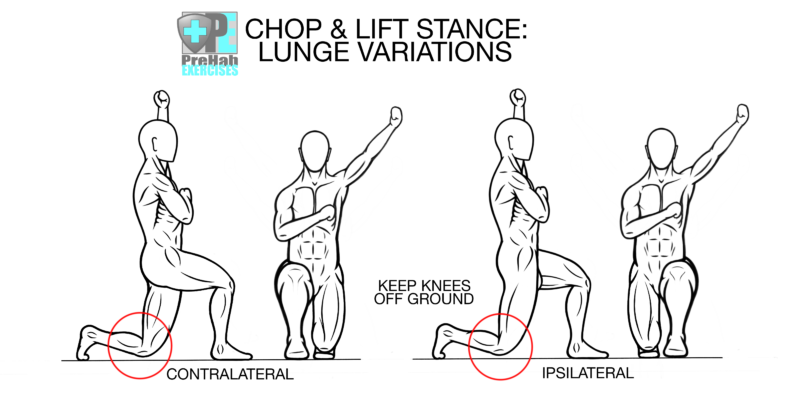
Lunge Stance – the Lunge Stance is similar to the stagger stance but with greater knee flexion. Just like the Stagger Stance, the Lunge Stance can be manipulated by Stance Orientation, Foot Position, and Leg Positioning.
Benefits: the Lunge Stance offers higher levels of activation in the lower body and can easily be used to help train the fitness components of strength, power, and endurance.
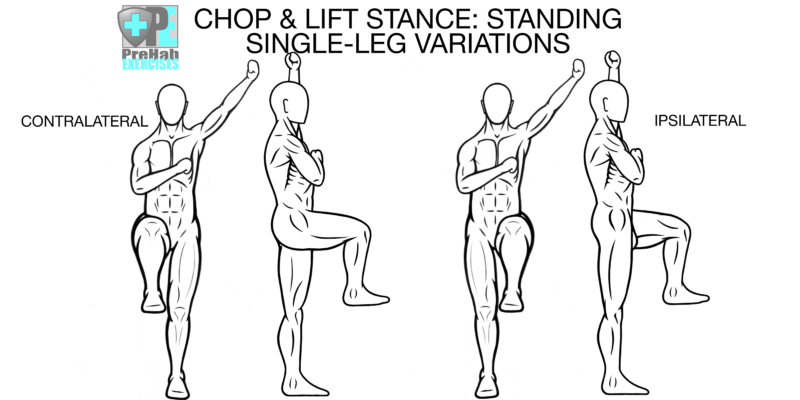
Single Leg Stance – the single leg stance marks the peak of instability in the progression of Chops and Lifts. This stance offers the smallest Base of Support and will effectively challenge the body’s ability to maintain equilibrium while performing the Chop or Lift. The single leg stance can be oriented as Contralateral or Ipsilateral, each of which offer different challenges in regards to Motor Control.
Benefits: The single leg stance places a large demand on and requires activation of the Hip, Ankle and Foot. Additionally this stance introduces an increased neurological challenge to maintain equilibrium, or a state in which the opposing forces that maintain balance of the body are in an equal and opposite state.
Note: Even though the single leg stance offers the greatest amount of instability, there is no guarantee that this variation of the Chop and Lift will bring forth the most appropriate or sought after adaption or results from training.

Here is an illustrative depiction of the basic Stance Progression, starting with the most stabile stance and progressing to the most complex and instable stance.
EXERCISE PRESCRIPTION – SETS AND REPS
As mentioned before, the Chop and Lift can be used to accomplish any of the three following training objectives: Corrective Exercise Strategy, Movement Prep and/or Training a Fitness Component, ie strength, power, endurance and more.
The Exercise Prescription for the Chop and Lift will vary based upon the training objective, as well as the individual’s level of fitness and competence.
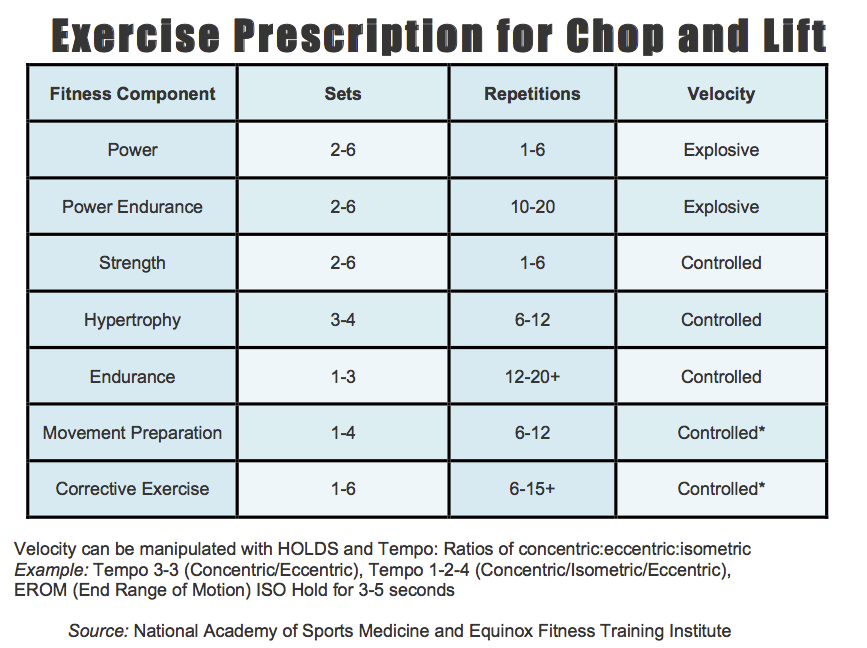
CONCLUSION – Final Thoughts
The Chop and Lift is an exercise that allows you to plug a gap in many training programs and can be used to assist in addressing a variety of compensation patterns, deficiencies, and deficits in movement quality. More importantly, the Chop and Lift can effectively develop Stability and Integration in an individual’s movement, which can lead to improved performance and longevity in a given activity.
Use the Chop and Lift in a training program to help further overall development of an individual.
Additional Resources:
Kelso, J. S. (2012). Multistability and metastability: understanding dynamic coordination in the brain. Phil. Trans. R. Soc. B, 367(1591), 906-918.
Frank, C., Kobesova, A., & Kolar, P. (2013). Dynamic neuromuscular stabilization & sports rehabilitation. International journal of sports physical therapy, 8(1), 62.
Movement Matters: Essays on Movement Science, Movement Ecology and the Nature of Movement – Bowman, Katy (2016)
Move Your DNA: Restore Your Health Through Natural Movement, Expanded Edition– Bowman, Katy (2017)
Smethurst, C. J., & Carson, R. G. (2001). The acquisition of movement skills: Practice enhances the dynamic stability of bimanual coordination. Human movement science, 20(4), 499-529.
Equinox Fitness Training Institute – Curriculum for Tier 2 and Tier 3 – Equinox Fitness 2016
Cook, G. (2010). Movement: Functional Movement Systems: Screening, Assessment, Corrective Strategies. On Target Publications.
Katzmarzyk, P. T., Church, T. S., Craig, C. L., & Bouchard, C. (2009). Sitting time and mortality from all causes, cardiovascular disease, and cancer. Medicine & Science in Sports & Exercise, 41(5), 998-1005.
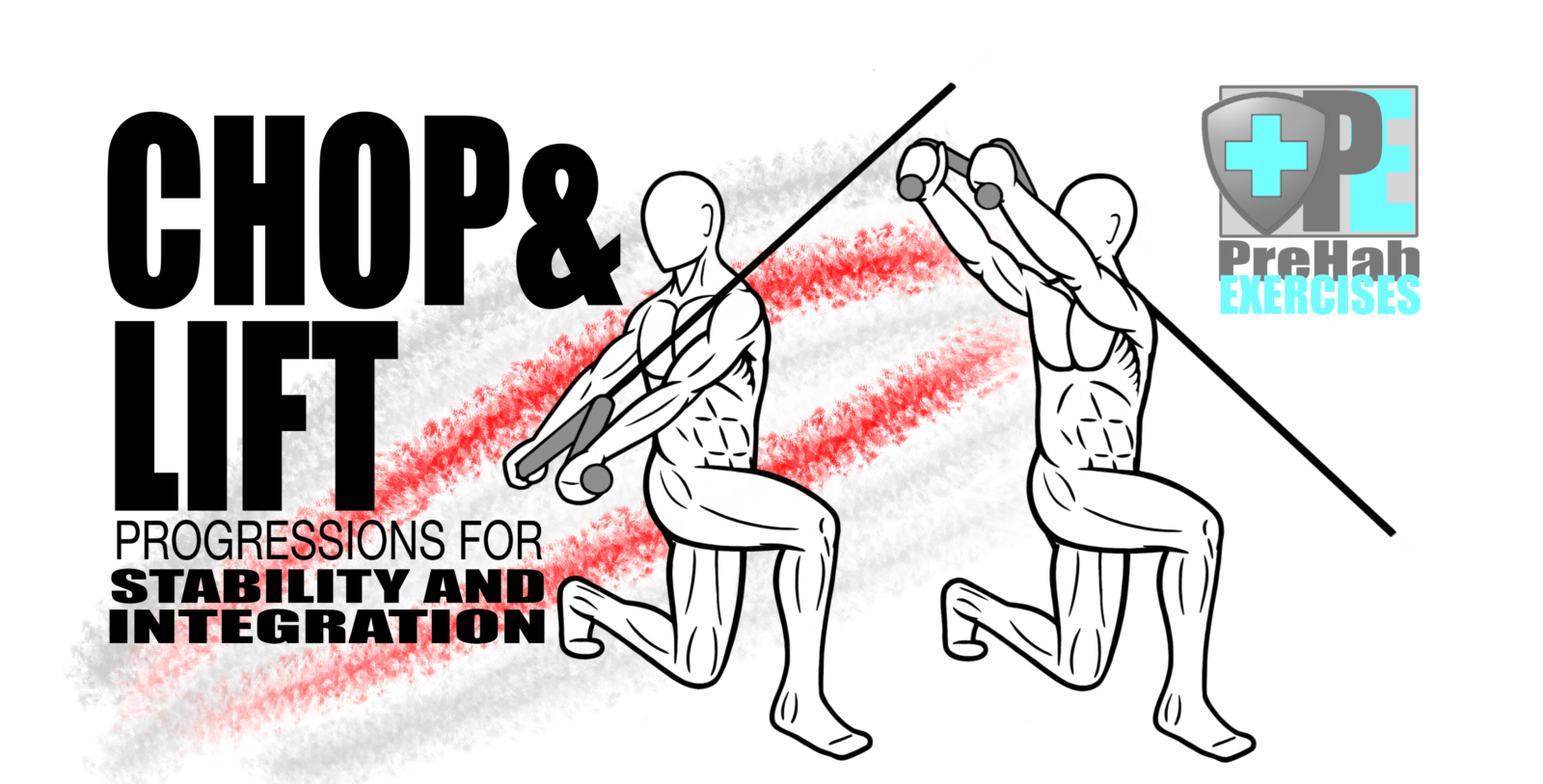
One thought on “Chop and Lift Progressions for Stability and Integration”
Comments are closed.